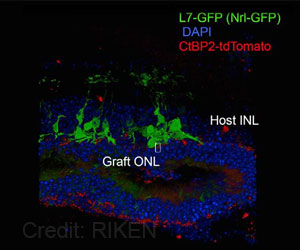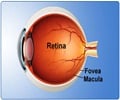Highlights:
- Retinal degeneration causes progressive loss of vision and has no cure at present.
- Zebrafish possess mechanism to self-repair their retinas with restoration of vision.
- Low levels of GABA, an inhibitory neurotransmitter found to trigger self-repair of damaged retina in zebrafish.
- Similar mechanism could be induced in human retinas.
Reason for the Study
Retinal degeneration is a common cause of loss of vision and it is estimated that by 2020 196 million persons worldwide will suffer from age related macular degeneration. Currently there is no cure though vision aids and other treatments help in reducing progression.Interestingly, the structure of the retinas of fish and mammals are quite similar. The retina is very thin - less than 0.5 millimeters thick, but it contains three layers of nerve cells or photoreceptors that detect the light, horizontal cells that process the signals from the photoreceptors and ganglion cells that receive the visual information and transmit it to the brain.
This prompted the research team to determine the mechanism that led to self-repair of damaged retinas in zebrafish and its potential application in human retinal degeneration.
Role of Muller Glia in Retinal Repair in Fish
The retina consists of a special type of adult stem cell, the Müller glia, that span all the three layers providing mechanical strength as well as electrical insulation. They have been found to also play a key role in repair of retinal cells. When regeneration is stimulated, the Muller glia dedifferentiate (regress from a specialized state to a simpler state), and start to divide, and then differentiate into replacements for the different types of damaged nerve cells. Muller glia are also found in human retinas, but have not been shown to regenerate.
Earlier studies have found GABA, an inhibitory neurotransmitter to influence stem cell activity in mouse hippocampus. The study authors were inspired by the results to determine whether a similar mechanism might operate in the zebrafish retina inducing the Muller glia to differentiate.
The team tried out their hypothesis in two ways:
- They blinded zebrafish and then injected them with drugs that caused increased GABA release and
- They injected normal zebrafish with an enzyme that lowers the GABA levels in their eyes.
Zebrafish can be easily blinded. If they remain in total darkness for several days and then exposed to very bright light, it results in the destruction of all the photoreceptors in their eyes. However, because of their robust regenerative capacity, vision is restored in just 28 days.
- When the biologists injected drugs that increased GABA levels in the blinded fish, they found that it suppressed the reparative process.
- When they injected an enzyme that reduces GABA concentrations in the eyes of normal fish, the Muller glia began dedifferentiating and dividing, marking the first step in the regeneration process.
Newfound Role for Inhibitory Neurotransmitter GABA
The authors are excited by the results of their study since another recently published study has shown that GABA concentrations influence regeneration of pancreas cells too.
"Last month a paper was published in the journal Cell that reports GABA levels play a central role in the regeneration of pancreas cells," said Patton. "We now have three instances where GABA is involved in regeneration - the hippocampus, the pancreas and the retina - so this could be an important, previously unknown role for the neurotransmitter."
Future Research Plans
Following the results of their current study, the team plan to determine in both zebrafish and mice whether
- GABA could cause differentiation that leads to the formation of new photoreceptors and other specialized nerve cells in the retina.
- Fish eyes may hold key to regenerating human retinas - (https://news.vanderbilt.edu/2017/03/09/fish-eyes-may-hold-key-to-regenerating-human-retinas)










